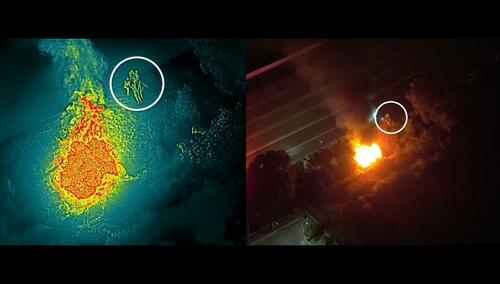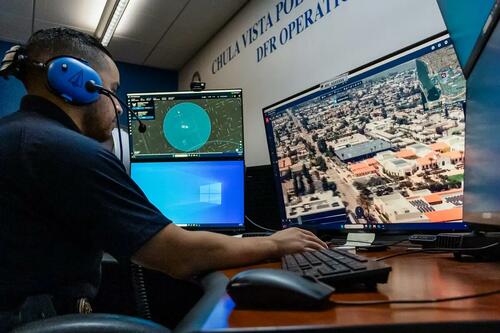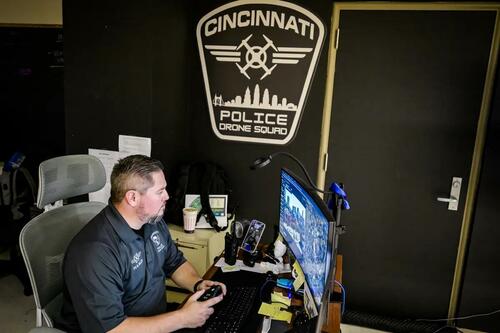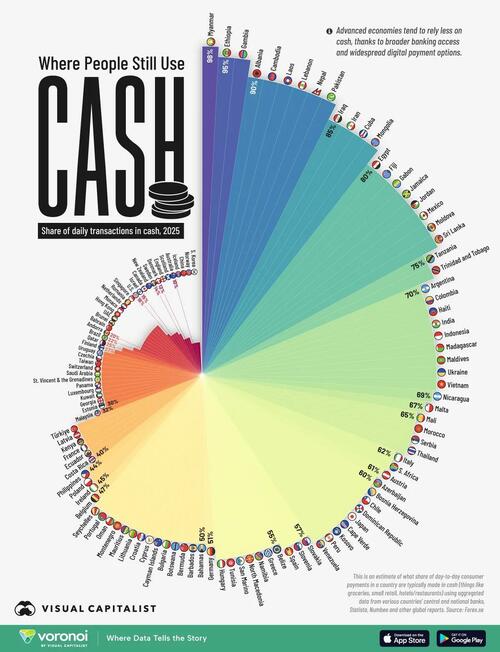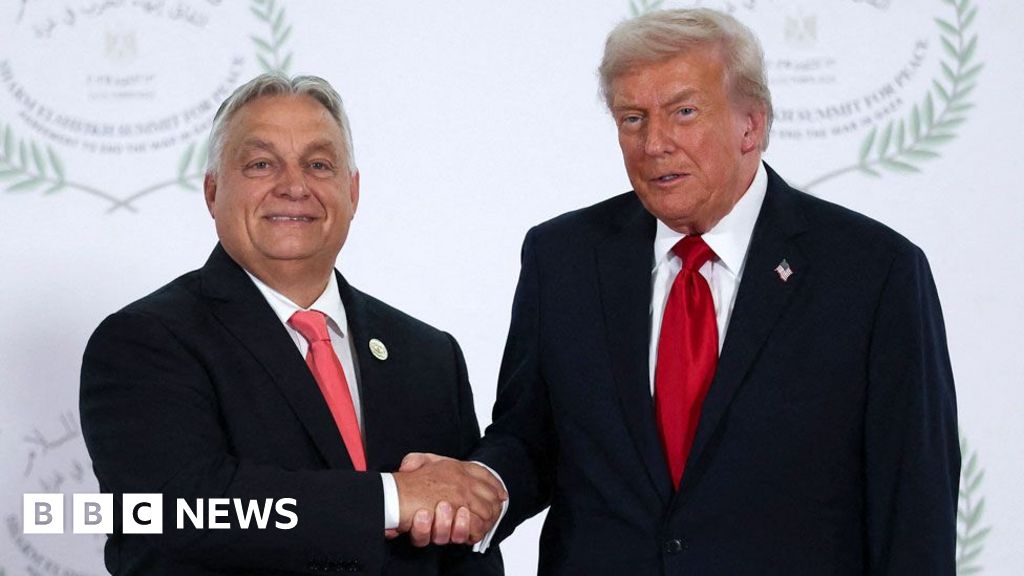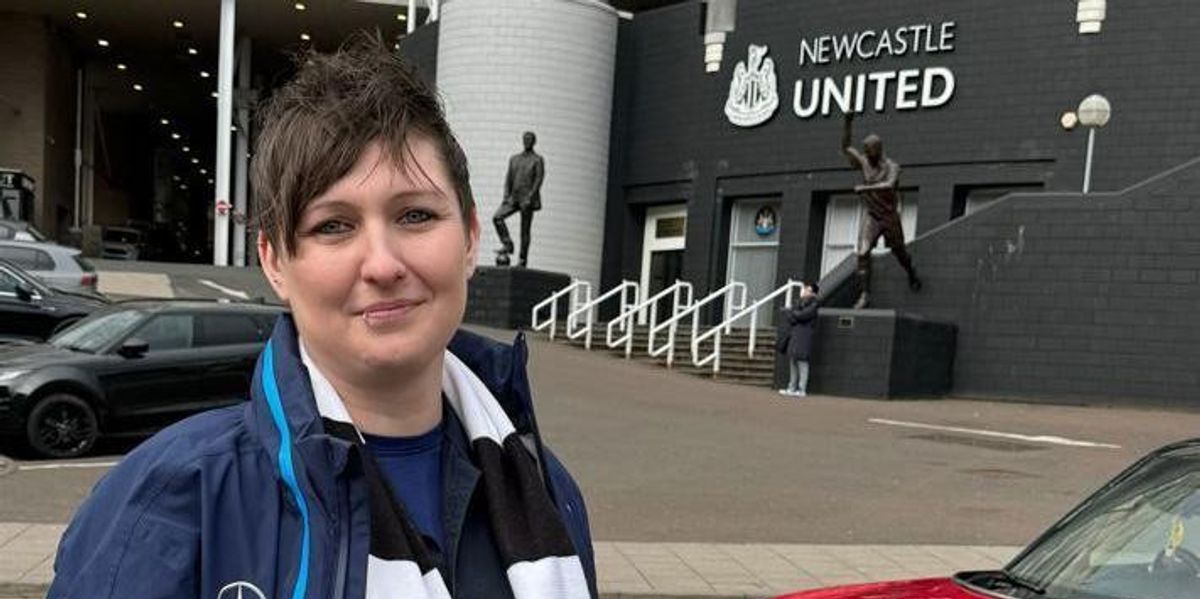The Technology That Police Call A Game-Changer, And Raises Privacy Concerns
Authored by Janice Hisle via The Epoch Times (emphasis ours),
CHULA VISTA, Calif.—The scene that unfolded along Interstate 5 looked like a carefully choreographed action-film sequence. But it was a real life-or-death situation.
Flames and smoke billowed into the night sky from a vehicle that had crashed off the roadway. Upon arrival, police discovered that the car’s driver was trapped inside, screaming in agony.
“C’mon, give me your hand!” an officer yelled, as he and three others worked frantically to extricate the man through a rear window they had broken.
Panting and grunting, the officers struggled. Then, seconds after they pulled the man to safety along the highway’s berm, the car exploded. A ball of fire engulfed it—just as a fire truck arrived.
The Hollywood-worthy timing, captured on video, is breathtaking.
“That guy probably would have perished,” Chula Vista Police Capt. John English said, if not for the officers’ heroism—and the aid of a camera-equipped, airborne drone.
By relaying real-time information to officers as they head to emergencies such as this one, drones help police plan their actions.
English reviewed video of the fiery rescue with The Epoch Times, explaining how a drone helped officers save the man’s life.
As the car burned, the drone’s aerial view allowed police to quickly identify the best route to the scene. Without that perspective, officers easily could have chosen a more distant highway entrance. “That would have taken extra time to get there—and they didn’t have it,” English said.
Also, because the drone’s thermal imaging showed no person near the burning car, officers suspected someone might still be inside the wreckage. That fear increased their sense of urgency, helping to avert tragedy.
Although the man and three of the four rescuing officers were hurt, all recovered. That incident, on Oct. 13, 2023, stands out as a dramatic example of how drones are bolstering police work across the nation.
Officers have used terms such as “game-changer,” “transformational,” and “revolutionary” to describe the impact of drones on their jobs.
Others are raising alarms over this technology’s capability to be intrusive.
In Eureka, a city of about 25,000 people in northern California, opponents recently stopped local police from even looking into a drone program.
The city’s police had relied on outside agencies for drone assistance in several situations, such as locating armed suspects near school campuses, and negotiating with a suicidal person who threatened to leap from the city water tower. Lacking a local drone fleet “can limit timely access to this critical resource,” officials said, explaining the reason for the proposed study.
After citizens pressured city leaders to back away from the idea, the city announced that the proposed drone study was cut from city council’s Oct. 21 agenda.
An opposition group, which declared victory on its website, said it expects the city to resurrect the proposal. If that happens, “We vow to keep fighting surveillance overreach … [to] preserve our integrity, safety, and privacy in our rapidly changing world.”
Advocates say that police already are following standard procedures that safeguard people’s privacy while greatly enhancing public safety. They consider drones a crucial asset at a time when many police agencies are understaffed and underfunded.
From Rescues to Arrests
In the seven years since Chula Vista pioneered using drones as first responders, increasing numbers of police and fire agencies have adopted the technology.
Some, including Chula Vista, still use advanced, affordable drones from DJI—a source of security concerns because the company is based in China, which has a history of stealing American technology and data.
Chula Vista says its devices have always operated with U.S.-based software “to bypass the drone manufacturer’s systems.” Data from the drones is encrypted and stored on U.S.-based servers “that meet federal requirements for confidential law enforcement databases,” the police department’s website states.
Skydio, a U.S. company, supplies drones to 800 public safety agencies, including New York City, where police are using the aircraft to quell the dangerous trend of riding on top of subways—known as “subway surfing.”
In Cincinnati, which sits along the Ohio River, police used a drone to track a felony suspect who jumped into the water and tried to swim away.
In Redmond, Washington, officers used a drone to reveal the hidden location of a missing elderly man with dementia. He was found safe, sitting in a wooded area.
Police in all three cities run drone first response programs. Drones go airborne to relay and record live video images from scenes where people reported disturbances or circumstances that appear to imperil lives, safety, or property.
Across America, officers credit drones with improving police safety and efficiency. Drones also help police rescue people, de-escalate contentious situations, and arrest suspects.
“We hear more and more reports from our customers about people actually surrendering to drones,” Skydio CEO Adam Bry said at a 2024 conference in California.
His audience had just watched a staged, live demonstration of a remote police officer using a drone to track a fleeing suspect. Using the drone’s loudspeaker, the officer ordered him to put his hands up and walk toward on-scene police. Such an outcome “is not far-fetched at all,” Bry said.
Chula Vista Laid Groundwork
Jon Beal, CEO of the Law Enforcement Drone Association, said he expects the drone first responder trend to grow rapidly, largely because of “trailblazers” such as Chula Vista.
That department’s leaders “stuck their necks out” to figure out drone methods that are now being replicated across the nation, he said, noting that departments fine tune policies to meet each community’s needs.
Over the years, the Federal Aviation Administration (FAA) has been removing approval obstacles.
And President Donald Trump’s June executive order supporting expansion of drone use in the United States further aims to streamline the administration’s processes for drones.
It builds on a directive he issued during his first presidency, ordering agencies to update regulations for “unmanned aircraft systems”—the technical term for drones and their related equipment—while ensuring safe operations. He aims to spur drone use in sectors ranging from agriculture to commerce and emergency management.
Applause and Concerns
The technology’s role in law enforcement has become increasingly important, Beal said. “We believe we’re getting to that place where … it’s almost negligent” if departments fail to use every tool available—including drones, he said.
That’s particularly true in “search-for-persons operations” and high-risk incidents, Beal said. Those might include police serving search warrants targeting dangerous people or responding to shootings-in-progress, unruly crowds, or standoffs with barricaded suspects.
In such circumstances, the high-tech devices give officers two new advantages: “an eye in the sky and time on their side,” Beal said.
About 2,500 police agencies own at least one drone, and 400 police departments run some type of drone program, Beal estimated.
Those numbers are low, considering America is home to about 18,000 federal, state, and local law enforcement agencies.
But “we’ve got law enforcement agencies buying drones on a daily basis,” Beal said.
Agencies that lack their own drones often borrow them from neighboring departments.
And, as agencies’ drone use expands, people on both sides of the political aisle are raising concerns, Beal acknowledged.
In Eureka, California, an Oct. 17 social media post from a group calling itself “The Humboldt Area Center for Harm Reduction” called drones “militarized police technology” and “fascist.”
“Research is only the first step,” the post said, alleging police would move toward “a military drone surveillance program.”
Beal said it’s impractical—and irresponsible—for agencies to deploy drones for general surveillance. It makes no sense for officials to say, “Hey, we’re gonna go out and fly a drone for 10 hours today and hopefully find something,” he said.
Misusing the technology, he said, could ignite backlash against drone programs across America.
Beal’s 2,000-member nonprofit helps train drone operators and sets standards to ensure that the technology is being used “the right way,” he said. His group assists public safety agencies not only across America but also in Canada, Europe, South America, and Australia.
Tales From Two Cities
To learn more about police drones, The Epoch Times visited Chula Vista as well as Cincinnati’s new program, which began this summer.
Although the two departments are located 2,200 miles apart and serve starkly dissimilar communities, both follow some of the same key principles. Their drone pilots must be federally certified, and policies prohibit general patrolling or random surveillance with drones.
Unique factors affect police drone operations in each city.
Chula Vista, which means “pretty view” in Spanish, enjoys Southern California weather that is reliably clear and sunny—ideal drone-flying conditions.
And it is a low-rise city, with buildings mostly 20 stories or lower—simplifying drones’ flight paths.
The police headquarters building is only about four stories high, but its rooftop enables a miles-wide view. It’s one of the locations from which police launch drones.
Under federal rules, a person must be present at the site; that’s typically a contractor who performs maintenance on the drones and coordinates flights with a drone operator inside the building. The indoor employees operate controls and monitor computer displays of maps and of drone-collected images.
In contrast, Cincinnati faces more obstacles for its drone flights.
Midwest weather tends to be more fickle, and skyscrapers form the Queen City’s distinctive skyline—posing challenges for drones. Tall buildings can disrupt GPS signals that guide the aircraft. The structures also may create a “canyon wind effect” that can destabilize drones.
Numerous federal flight restrictions affect Cincinnati airspace, too. While Chula Vista lacks a professional sports team, Cincinnati is home to three: Reds baseball, Bengals football, and FC Cincinnati soccer. Those teams’ schedules and the presence or movement of Vice President JD Vance, whose permanent residence is in Cincinnati, all can cause the FAA to impose restrictions.
Read the rest here…
Loading recommendations…
Recent Top Stories
Sorry, we couldn't find any posts. Please try a different search.
